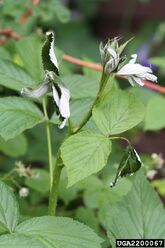| Raspberry horntail | |||||||||||||||||||||||||||||||||||||||||||||||||
|---|---|---|---|---|---|---|---|---|---|---|---|---|---|---|---|---|---|---|---|---|---|---|---|---|---|---|---|---|---|---|---|---|---|---|---|---|---|---|---|---|---|---|---|---|---|---|---|---|---|
 |
|||||||||||||||||||||||||||||||||||||||||||||||||
| A Raspberry horntail in the stem of a raspberry | |||||||||||||||||||||||||||||||||||||||||||||||||
| Scientific Classification | |||||||||||||||||||||||||||||||||||||||||||||||||
| Kingdom: | Animalia | ||||||||||||||||||||||||||||||||||||||||||||||||
| Phylum: | Arthropoda | ||||||||||||||||||||||||||||||||||||||||||||||||
| Class: | Insecta | ||||||||||||||||||||||||||||||||||||||||||||||||
| Order: | Diptera | ||||||||||||||||||||||||||||||||||||||||||||||||
| Family: | Sarcophagidae | ||||||||||||||||||||||||||||||||||||||||||||||||
| Genus: | Hartigia | ||||||||||||||||||||||||||||||||||||||||||||||||
| Species: | Hartidia cressonii | ||||||||||||||||||||||||||||||||||||||||||||||||
| Risk period | |||||||||||||||||||||||||||||||||||||||||||||||||
|
|||||||||||||||||||||||||||||||||||||||||||||||||
The Raspberry horntail (Hartidia cressonii) is a caneboring parasitic wasp. Horntails spend the winter as mature larvae in the previous year’s canes, pupate in the early spring, and emerge as adults to mate and lay eggs in first year canes just after cane growth begins.[2]
Symptoms[]
Beginning in April, female horntails insert their eggs just under the epidermis of both blackberry and raspberry canes, about 5cm (2in) below the tips. A few days later eggs hatch into very small larvae that spirally girdle the tips of the canes and cause wilting. In most cases the cane recovers, although they remain slightly crooked. The cane is weak in the area of the crook and often breaks at this point during pruning and training. Larvae later feed throughout the terminal portion of the cane, which often causes dieback. When mature, they burrow down the pith in canes and spend the winter in silk-lined cells in the burrows. In spring they pupate and adults emerge through a round hole cut in the sides of the canes. In some locations horntails may have two generations per year.[3]
Treatment[]
Low populations of horntails do not cause serious damage. Removing and destroying infested canes when wilting becomes apparent will remove the larvae from the patch and help reduce the total population.[3]
Prevention[]
Larvae may be parasitized by small wasps in the Ichneumonid family. These parasitic wasps occur naturally and are not commercially available for release. Use insecticides for control only when three actively wilting canes are counted per 100 feet of row. Begin monitoring in April. In order to avoid killing pollinating honeybees, do not spray insecticides during bloom.[3]
Examples[]
References[]
- ↑ Dreistadt, S.H.; Flint, M.L.; Clark, J.K. (2004). Pests of landscape trees and shrubs: an integrated pest management guide. Agriculture & Natural Resources; 2 edition. ISBN 978-1879906617.
- ↑ Alston, D.; Black, B.; Murray, M. (2009). Raspberry Horntail. Utah State University Extension and Utah Plant Pest Diagnostic Laboratory.
- ↑ a b c (2009). Caneberries - Raspberry Horntail. University of California, Agriculture and Natural Resource. UC Pest Management Guidelines. Retrieved: 2010-09-19.
| Raspberry troubles |
|
|---|---|
| Adverse conditions | |
| Diseases | Anthracnose · Cane and leaf rust · Cercosporella leaf spot · Downy mildew · Arabis mosaic virus · Orange rust · Phytophthora root rot of raspberry · Raspberry leaf curl virus · Raspberry leaf spot · Raspberry ringspot virus · Rose scale · Septoria leaf spot of blackberry · Spur blight |
| Pests | Raspberry beetle · Raspberry horntail |

